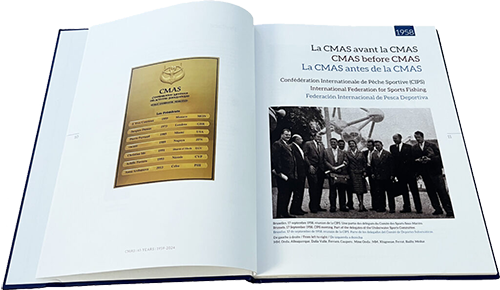Underwater Cultural Heritage
CMAS, a global non-profit organization, works to protect Underwater Cultural Heritage (UCH) through special training programs and awareness methods. This approach involves collaborating with scientists and scientific organizations to enlighten people about the archaeological value of sunken cultural objects.
CMAS has elected several underwater archaeology professors, including Associate Professor Dr Hakan Öniz from the Akdeniz University of Turkey as the director of the UCH Committee. Other members include Professor Emad Khalil from Alexandria University of Egypt and Dr Gustau Vivar from Catalunya Museum of Spain. Together, they work in the UNESCO UniTwin Underwater Archaeology Network and ICOMOS International Committee of Cultural Heritage to protect and preserve underwater cultural heritage.
According to UNESCO, underwater cultural heritage is defined as all traces of human existence of a cultural, historical, or archaeological nature that have been partially or totally immersed for at least 100 years. Protection and preservation of UCH allow for better knowledge and appreciation of past culture, history, and science. The 2001 Convention on the Protection of the Underwater Cultural Heritage provides a legally binding framework for state parties to identify, research, and protect their underwater heritage while ensuring its preservation and sustainability. CMAS supports UNESCO's 2001 Convention and has planned a special training program in collaboration with UNESCO. The book of the program is ready. “Protection of Underwater Cultural Heritage” book is written by 7 underwater archaeology professors and edited by Hakan Öniz, Emad Khalil and Gustau Vivar. The name of the book is “Protection of Underwater Cultural Heritage”.
The International Committee on the Underwater Cultural Heritage (ICUCH) was founded in 1991 by the International Council on Monuments and Sites (ICOMOS) Australia to promote international cooperation in the protection and management of underwater cultural heritage. ICUCH is composed of international experts in underwater cultural heritage and is mainly working on the ethics and practices of underwater cultural heritage management. CMAS has been working closely with ICOMOS-ICUCH due to common members on their boards.
Cultural heritage values that lie deep in seas, lakes, and streams are often not noticed, making them particularly vulnerable. Underwater archaeologists study these values, which face numerous risks today, including treasure hunting, looting, and commercial exploitation, as well as environmental degradation and coastal development. Underwater cultural heritage is fascinating as it provides a glimpse into the past, but it loses some of its meaning when exhibited on land, making efforts to create underwater museums and dive trails necessary.
The CMAS Scientific Committee aims to train CMAS diver instructors on the protection of underwater cultural heritage. This involves special education programs, preparing necessary materials, and creating an examination and certification system. The first step is preparing a book titled “Protection of Underwater Cultural Heritage”, which is being written and edited by academics and experts in underwater archaeology from around the world. The book is set to be published by CMAS in at least 6 languages and is prepared according to the principles and recommendations of UNESCO and the International Council on Monuments and Sites (ICOMOS). The purpose of the book is to provide an approach and a knowledgebase to prevent damage to archaeological heritage by divers. The book also aims to inform relevant institutions about the cultural values found underwater, subsequently passing them on to future generations and bringing them to the heart of global science.
The CMAS UCH Directorship has another objective, one that aims to arrange training programs for instructors to safeguard underwater cultural heritage. This program, supported by UNESCO UniTwin Underwater Archaeology Network and ICOMOS-ICUCH, trains diving instructors to educate their students on the proper treatment of artefacts encountered underwater. The program is led by voluntary experts from local universities who provide clear and accessible guidance on artefact handling and reporting. Participants who complete the program receive a certificate and pledge to preserve the underwater cultural heritage.
In addition, CMAS introduced new hand signs for Underwater Cultural Heritage in 2021, which were implemented by Akdeniz University in Turkey. These signs enable better communication and help to protect cultural treasures. CMAS urges divers not to disturb archaeological and historical objects in the water and to contact the nearest museum or governmental institution for assistance. Let's work together to protect underwater cultural heritage for future generations!
REFERENCES
https://en.unesco.org/underwater-heritage/2001
https://icuch.icomos.org/
O. Schill , Ralph, CMAS Press Release, 20.1.2021
https://www.reutersevents.com/travel/social-media-and-marketing/deepblu-takes-social-dive-billion-dollar-market
Öztosun, Ceyda. PhD Thesis to PAN -Polish Academy of Science, Polish Ethnology and Archaeology Institute, 2023
ref wireframes: Scientific Environment At A Glance & Aout Environment & Sustainability
Cultural Heritage Projects
While the Red Sea is best known for its coral reefs and close encounters with a great diversity of marine creatures, the Red Sea is also teeming with numerous UCH sites including several 19th and 20th-century wrecks, surrounded by mysteries and adventures. The SS Thistlegorm, the Dunraven, the Giannis D, and the SS Carnatic are among the most famous shipwrecks in the Red Sea, offering divers endless opportunities for exploration and enjoyment.
Due to the historical, cultural and economic value of these shipwrecks the University of Edinberg and the University of Alexandria, are conducting the Wrecks at Risk Project, which aims to document these wrecks and develop sustainable management plans for these cultural assets. One of the outstanding outcomes of the project is creating 3D digital models and virtual underwater tours for these splendor shipwrecks.
For more information please contact: info@ema.org

